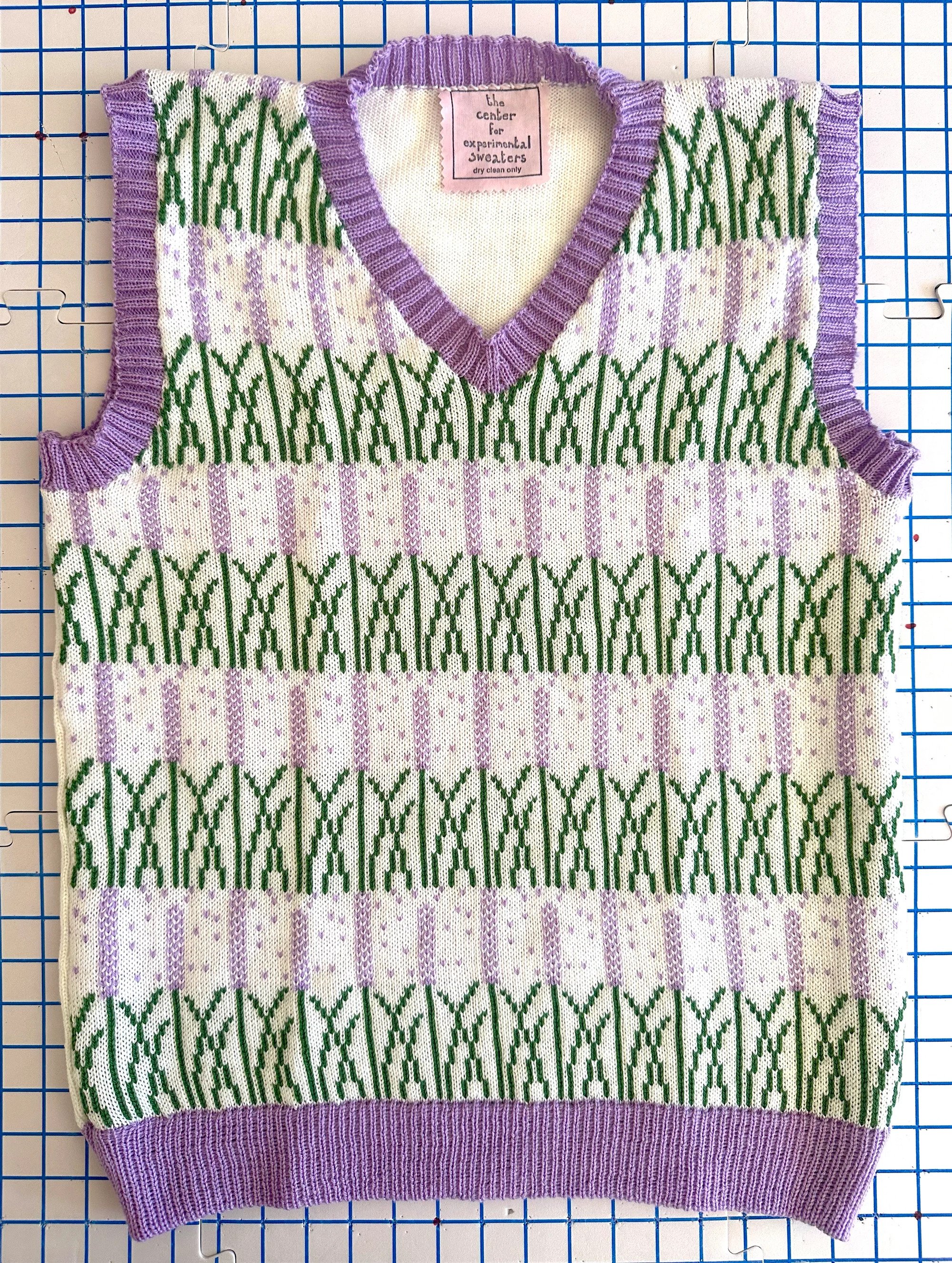 Image 1 of
Image 1 of


Lavender Sweater Vest - White
The Center for Experimental Sweaters by Josh Faught produces small editions of wearable objects.
Established in 2024, all works are produced on a Brother KH-940 Knitting Machine. Similar to other standard gauge domestic knitting machines, the KH-940 works by passing a threaded carriage over a bed of latch hooks to produce the desired fabric. In earlier iterations of the knitting machine, pattern was produced through the use of hand punched cards. A binary system, these cards allowed two yarns to knit simultaneously: producing the characteristic knit/float structure, known as Fairisle. The KH-940, released in 1988, was the third electronic machine produced by Brother. By incorporating low-tech circuitry, the machine allowed users to store up to 555 designs into its memory or connect the knitting machine to a computer as a way to circumvent the hand punched cards. The KH-940 and the knitting machines of the 1980s and 1990s produced a generation of vivid, graphic, knit sweaters: anthemic apparel that fashioned two decades of political, personal, and corporeal upheaval for queer people. By 1997, Brother discontinued producing its knitting machines for the domestic market, coincidentally the same year that Protease Inhibitors and combination therapies radically altered the trajectory of the HIV/AIDS epidemic.
The Center for Experimental Sweaters exists within these potent obscure technologies. These objects, and the machines that produce them challenge the politics of taste: celebrating the gaudy, the misshapen, and the unfashionable. They also bear witness to a generation caught between illness and survival, speaking through now illegible codes of community signification. *Josh Faught also has work in the DC exhibition, 'You Stretched Diagonally Across It: Contemporary Tapestry.'
One Size Only
41" chest
17" shoulder to shoulder
8" neck
26.75" total length
13.5" hem to armhole
2.5" bottom hem
1" neck and arm bands
The Center for Experimental Sweaters by Josh Faught produces small editions of wearable objects.
Established in 2024, all works are produced on a Brother KH-940 Knitting Machine. Similar to other standard gauge domestic knitting machines, the KH-940 works by passing a threaded carriage over a bed of latch hooks to produce the desired fabric. In earlier iterations of the knitting machine, pattern was produced through the use of hand punched cards. A binary system, these cards allowed two yarns to knit simultaneously: producing the characteristic knit/float structure, known as Fairisle. The KH-940, released in 1988, was the third electronic machine produced by Brother. By incorporating low-tech circuitry, the machine allowed users to store up to 555 designs into its memory or connect the knitting machine to a computer as a way to circumvent the hand punched cards. The KH-940 and the knitting machines of the 1980s and 1990s produced a generation of vivid, graphic, knit sweaters: anthemic apparel that fashioned two decades of political, personal, and corporeal upheaval for queer people. By 1997, Brother discontinued producing its knitting machines for the domestic market, coincidentally the same year that Protease Inhibitors and combination therapies radically altered the trajectory of the HIV/AIDS epidemic.
The Center for Experimental Sweaters exists within these potent obscure technologies. These objects, and the machines that produce them challenge the politics of taste: celebrating the gaudy, the misshapen, and the unfashionable. They also bear witness to a generation caught between illness and survival, speaking through now illegible codes of community signification. *Josh Faught also has work in the DC exhibition, 'You Stretched Diagonally Across It: Contemporary Tapestry.'
One Size Only
41" chest
17" shoulder to shoulder
8" neck
26.75" total length
13.5" hem to armhole
2.5" bottom hem
1" neck and arm bands
The Center for Experimental Sweaters by Josh Faught produces small editions of wearable objects.
Established in 2024, all works are produced on a Brother KH-940 Knitting Machine. Similar to other standard gauge domestic knitting machines, the KH-940 works by passing a threaded carriage over a bed of latch hooks to produce the desired fabric. In earlier iterations of the knitting machine, pattern was produced through the use of hand punched cards. A binary system, these cards allowed two yarns to knit simultaneously: producing the characteristic knit/float structure, known as Fairisle. The KH-940, released in 1988, was the third electronic machine produced by Brother. By incorporating low-tech circuitry, the machine allowed users to store up to 555 designs into its memory or connect the knitting machine to a computer as a way to circumvent the hand punched cards. The KH-940 and the knitting machines of the 1980s and 1990s produced a generation of vivid, graphic, knit sweaters: anthemic apparel that fashioned two decades of political, personal, and corporeal upheaval for queer people. By 1997, Brother discontinued producing its knitting machines for the domestic market, coincidentally the same year that Protease Inhibitors and combination therapies radically altered the trajectory of the HIV/AIDS epidemic.
The Center for Experimental Sweaters exists within these potent obscure technologies. These objects, and the machines that produce them challenge the politics of taste: celebrating the gaudy, the misshapen, and the unfashionable. They also bear witness to a generation caught between illness and survival, speaking through now illegible codes of community signification. *Josh Faught also has work in the DC exhibition, 'You Stretched Diagonally Across It: Contemporary Tapestry.'
One Size Only
41" chest
17" shoulder to shoulder
8" neck
26.75" total length
13.5" hem to armhole
2.5" bottom hem
1" neck and arm bands
